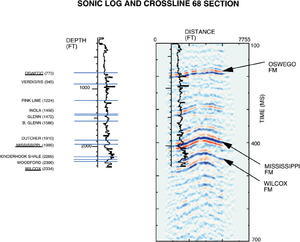Difference between revisions of "Seismic data: identifying reflectors"
FWhitehurst (talk | contribs) |
Cwhitehurst (talk | contribs) m (added Category:Treatise Handbook 3 using HotCat) |
||
| (5 intermediate revisions by 2 users not shown) | |||
| Line 6: | Line 6: | ||
| part = Predicting the occurrence of oil and gas traps | | part = Predicting the occurrence of oil and gas traps | ||
| chapter = Interpreting seismic data | | chapter = Interpreting seismic data | ||
| − | | frompg = 12- | + | | frompg = 12-18 |
| − | | topg = 12- | + | | topg = 12-18 |
| author = Christopher L. Liner | | author = Christopher L. Liner | ||
| link = http://archives.datapages.com/data/specpubs/beaumont/ch12/ch12.htm | | link = http://archives.datapages.com/data/specpubs/beaumont/ch12/ch12.htm | ||
| Line 18: | Line 18: | ||
==Example== | ==Example== | ||
| − | [[file:interpreting-seismic-data_fig12-8.png|300px|thumb|{{figure number|1}}Sonic log converted to time and velocity. . | + | [[file:interpreting-seismic-data_fig12-8.png|300px|thumb|{{figure number|1}}Sonic log converted to time and velocity. From Liner;<ref name=Liner1999>Liner, C., 1999, Elements of 3-D Seismology: Tulsa, PennWell.</ref> courtesy PennWell.]] |
In [[:file:interpreting-seismic-data_fig12-8.png|Figure 1]], a [[Basic open hole tools#Sonic|sonic]] log has been converted to time and velocity. Note that the time axis on the seismic section and the converted sonic log are linear, while the depth tick marks on the sonic are nonlinear. The geological horizons annotated on the sonic log are located via the depth ticks from picks on other logs ([[Basic open hole tools#Resistivity|electric]], [[Basic open hole tools#Gamma ray|gamma ray]], etc.). It is important to realize that a sonic log never goes to the surface; there is always a gap for the [[surface casing]]. We do not expect time zero on the converted log to fit at time zero on the seismic section. In practice, the log is placed over the seismic section and shifted vertically until we are satisfied with the fit. | In [[:file:interpreting-seismic-data_fig12-8.png|Figure 1]], a [[Basic open hole tools#Sonic|sonic]] log has been converted to time and velocity. Note that the time axis on the seismic section and the converted sonic log are linear, while the depth tick marks on the sonic are nonlinear. The geological horizons annotated on the sonic log are located via the depth ticks from picks on other logs ([[Basic open hole tools#Resistivity|electric]], [[Basic open hole tools#Gamma ray|gamma ray]], etc.). It is important to realize that a sonic log never goes to the surface; there is always a gap for the [[surface casing]]. We do not expect time zero on the converted log to fit at time zero on the seismic section. In practice, the log is placed over the seismic section and shifted vertically until we are satisfied with the fit. | ||
| Line 25: | Line 25: | ||
* [[Seismic data: building a stratigraphic model]] | * [[Seismic data: building a stratigraphic model]] | ||
* [[Synthetic seismogram]] | * [[Synthetic seismogram]] | ||
| − | * [[ | + | * [[Synthetic seismograms: correlation to other data]] |
| + | |||
| + | ==References== | ||
| + | {{reflist}} | ||
==External links== | ==External links== | ||
| Line 36: | Line 39: | ||
[[Category:Exploring for stratigraphic traps]] | [[Category:Exploring for stratigraphic traps]] | ||
[[Category:Exploring for structural traps]] | [[Category:Exploring for structural traps]] | ||
| + | [[Category:Treatise Handbook 3]] | ||
Latest revision as of 19:10, 27 January 2022
| Exploring for Oil and Gas Traps | |

| |
| Series | Treatise in Petroleum Geology |
|---|---|
| Part | Predicting the occurrence of oil and gas traps |
| Chapter | Interpreting seismic data |
| Author | Christopher L. Liner |
| Link | Web page |
| Store | AAPG Store |
Whether using VSP, synthetic seismogram, or log overlay, the final step is to compare the object to seismic traces in the vicinity of the well and find a fit.
Example

In Figure 1, a sonic log has been converted to time and velocity. Note that the time axis on the seismic section and the converted sonic log are linear, while the depth tick marks on the sonic are nonlinear. The geological horizons annotated on the sonic log are located via the depth ticks from picks on other logs (electric, gamma ray, etc.). It is important to realize that a sonic log never goes to the surface; there is always a gap for the surface casing. We do not expect time zero on the converted log to fit at time zero on the seismic section. In practice, the log is placed over the seismic section and shifted vertically until we are satisfied with the fit.
See also
- Seismic data: building a stratigraphic model
- Synthetic seismogram
- Synthetic seismograms: correlation to other data
References
- ↑ Liner, C., 1999, Elements of 3-D Seismology: Tulsa, PennWell.